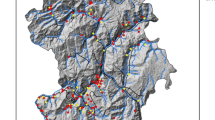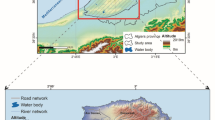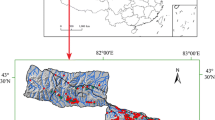Abstract
Predictive mapping of landslide occurrence at the regional scale was performed at Mt. Umyeon, in the southern part of Seoul, Korea, using an evidential belief function (EBF) model. To generate the landslide susceptibility map, approximately 90 % of 163 actual landslide locations were randomly selected as a training set, and about 10 % of them were used as a validation set. Spatial data sets relevant to landslide occurrence (topographic factors, hydrologic factors, forest factors, soil factors, and geologic factors) were analyzed in a geographic information system environment. In this study, landslide susceptibility was assessed on the basis of mass function assignment (belief, disbelief, uncertainty, and plausibility) and integration within a data-driven approach. The most representative of the resulting integrated susceptibility maps (the belief map) was validated using the receiver operating characteristic (ROC) method. The verification result showed that the model had an accuracy of 74.3 % and a predictive accuracy of 88.1 %. The frequency ratio (FR) model was also used for comparison with the EBF model. Prediction and success rates of 72.1 and 85.9 % were achieved using the FR model. The validation results showed satisfactory agreement between the susceptibility map and the existing landslide location data. The EBF model was more accurate than the FR model for landslide prediction in the study area. The results of this study can be used to mitigate landslide-induced hazards and for land-use planning.











Similar content being viewed by others
References
Abe K, Ziemer RR (1991) Effect of tree roots on shallow-seated landslides. USDA For Sci Gen Tech Rep PSW-GR 130:11–20
Akgun A, Kıncal C, Pradhan B (2012) Application of remote sensing data and GIS for landslide risk assessment as an environmental threat to Izmir City (west Turkey). Environ Monit Assess 184(9):5453–5470
Aleotti P, Chowdhury R (1999) Landslide hazard assessment: summary review and new perspectives. Bull Eng Geol Environ 58(1):21–44
Alon N, Spencer JH (2004) The probabilistic method. Wiley, Hoboken
Althuwaynee OF, Pradhan B, Lee S (2012) Application of an evidential belief function model in landslide susceptibility mapping. Comp Geos 44:120–135
Ayalew L, Yamagishi H (2005) The application of GIS-based logistic regression for landslide susceptibility mapping in the Kakuda-Yahiko Mountains. Central Japan Geomorp 65(1):15–31
Beven KJ, Kirkby MJ (1979) A physically based, variable contributing area model of basin hydrology/Un modèle à base physique de zone d’appel variable de l’hydrologie du bassin versant. Hydro Sci J 24(1):43–69
Bui DT, Pradhan B, Lofman O, Revhaug I, Dick OB (2012) Spatial prediction of landslide hazards in Hoa Binh province (Vietnam): a comparative assessment of the efficacy of evidential belief functions and fuzzy logic models. Catena 96:28–40
Caniani D, Pascale S, Sdao F, Sole A (2008) Neural networks and landslide susceptibility: a case study of the urban area of Potenza. Nat Haz 45(1):55–72
Carranza EJM, Hale M (2003) Evidential belief functions for data-driven geologically constrained mapping of gold potential, Baguio district, Philippines. Ore Geol Rev 22(1):117–132
Carranza EJM, Woldai T, Chikambwe EM (2005) Application of data-driven evidential belief functions to prospectively mapping for aquamarine-bearing pegmatites, Lundazi district, Zambia. Nat Resour Res 14(1):47–63
Carrara A, Cardinali M, Guzzetti F, Reichenbach P (1995) GIS technology in mapping landslide hazard. In: Geographical information systems in assessing natural hazards. Springer, Dordrecht, pp 135–175
Catani F, Casagli N, Ermini L, Righini G, Menduni G (2005) Landslide hazard and risk mapping at catchment scale in the Arno River basin. Landslides 2(4):329–342
Chung CJF, Fabbri AG (2003) Validation of spatial prediction models for landslide hazard mapping. Nat Haz 30(3):451–472
Chung YS, Yoon MB, Kim HS (2004) On climate variations and changes observed in South Korea. Clim Chan 66(1–2):151–161
Dahal RK, Hasegawa S, Nonomura A, Yamanaka M, Dhakal S, Paudyal P (2008) Predictive modelling of rainfall-induced landslide hazard in the Lesser Himalaya of Nepal based on weights-of-evidence. Geomorp 102(3):496–510
Dempster AP (1967) Upper and lower probabilities induced by a multivalued mapping. Ann Math Stat 38:325–339
Dempster AP (1968) A generalization of Bayesian inference. J R Stat Soc Ser B 30:205–247
Domínguez-Cuesta MJ, Jiménez-Sánchez M, Colubi A, González-Rodríguez G (2010) Modelling shallow landslide susceptibility: a new approach in logistic regression by using favourability assessment. Int J Earth Sci 99(3):661–674
Eker AM, Dikmen M, Cambazoğlu S, Düzgün ŞH, Akgün H (2015) Evaluation and comparison of landslide susceptibility mapping methods: a case study for the Ulus district, Bartın, northern Turkey. Int J Geogr Inf Sci 29(1):132–158
Ercanoglu M, Gokceoglu C (2004) Use of fuzzy relations to produce landslide susceptibility map of a landslide prone area (West Black Sea Region, Turkey). Eng Geol 75(3):229–250
Falaschi F, Giacomelli F, Federici PR, Puccinelli A, Avanzi GA, Pochini A, Ribolini A (2009) Logistic regression versus artificial neural networks: landslide susceptibility evaluation in a sample area of the Serchio River valley, Italy. Nat Hazards 50(3):551–569
Ghimire M (2011) Landslide occurrence and its relation with terrain factors in the Siwalik Hills, Nepal: case study of susceptibility assessment in three basins. Nat Hazards 56(1):299–320
Ghosh S, Carranza EJM, van Westen CJ, Jetten VG, Bhattacharya DN (2011) Selecting and weighting spatial predictors for empirical modeling of landslide susceptibility in the Darjeeling Himalayas (India). Geomorphology 131(1):35–56
Gökceoglu C, Aksoy H (1996) Landslide susceptibility mapping of the slopes in the residual soils of the Mengen region (Turkey) by deterministic stability analyses and image processing techniques. Eng Geol 44(1):147–161
Guzzetti F, Carrara A, Cardinali M, Reichenbach P (1999) Landslide hazard evaluation: a review of current techniques and their application in a multi-scale study, Central Italy. Geomorphology 31(1):181–216
Guzzetti F, Reichenbach P, Cardinali M, Galli M, Ardizzone F (2005) Probabilistic landslide hazard assessment at the basin scale. Geomorphology 72(1):272–299
Hanley JA, McNeil BJ (1982) The meaning and use of the area under a receiver operating characteristic (ROC) curve. Radiology 143(1):29–36
Hosmer Jr DW, Lemeshow S, Sturdivant RX (2000) Model‐building strategies and methods for logistic regression. In: Applied logistic regression, 3rd edn. Wiley, Hoboken, pp 89–151
Hutchinson JN (1995) Keynote paper: landslide hazard assessment. In: Bell DH (ed) Landslides. Balkema, Rotterdam, pp 1805–1841
Kanungo DP, Arora MK, Gupta RP, Sarkar S (2008) Landslide risk assessment using concepts of danger pixels and fuzzy set theory in Darjeeling Himalayas. Landslides 5(4):407–416
Kanungo DP, Arora MK, Sarkar S, Gupta RP (2009) A fuzzy set based approach for integration of thematic maps for landslide susceptibility zonation. Georisk 3(1):30–43
Klimeš J (2013) Landslide temporal analysis and susceptibility assessment as bases for landslide mitigation, Machu Picchu, Peru. Environ Earth Sci 70(2):913–925
Lee S (2005) Application of logistic regression model and its validation for landslide susceptibility mapping using GIS and remote sensing data. Int J Rem Sens 26(7):1477–1491
Lee S, Choi J (2004) Landslide susceptibility mapping using GIS and the weight-of-evidence model. Int J Geog Info Sci 18(8):789–814
Lee S, Pradhan B (2006) Probabilistic landslide hazards and risk mapping on Penang Island, Malaysia. J Earth Sys Sci 115(6):661–672
Lee S, Talib JA (2005) Probabilistic landslide susceptibility and factor effect analysis. Env Geol 47(7):982–990
Lee S, Hwang J, Park I (2013) Application of data–driven evidential belief functions to landslide susceptibility mapping in Jinbu, Korea. Catena 100:15–30
Mathew J, Jha VK, Rawat GS (2009) Landslide susceptibility zonation mapping and its validation in part of Garhwal Lesser Himalaya, India, using binary logistic regression analysis and receiver operating characteristic curve method. Landslides 6(1):17–26
McCalpin J (1984) Preliminary age classification of landslides for inventory mapping. In: Proc 21st Eng Geol Soil Eng Symp, Moscow, ID, USA, 5–6 April 1984
Miles SB, Keefer DK (2009) Evaluation of CAMEL—Comprehensive Areal Model of Earthquake-induced Landslides. Eng Geol 104(1):1–15
Moore ID, Burch GJ (1986) Physical basis of the length–slope factor in the universal soil loss equation. Soil Sci Soc Am J 50(5):1294–1298
Nampak H, Pradhan B, Manap MA (2014) Application of GIS based data driven evidential belief function model to predict groundwater potential zonation. J Hydrol 513:283–300
Nandi A, Shakoor A (2010) A GIS-based landslide susceptibility evaluation using bivariate and multivariate statistical analyses. Eng Geol 110(1):11–20
Nefeslioglu HA, Gokceoglu C, Sonmez H (2008) An assessment on the use of logistic regression and artificial neural networks with different sampling strategies for the preparation of landslide susceptibility maps. Eng Geol 97(3):171–191
Ozdemir A (2009) Landslide susceptibility mapping of vicinity of Yaka Landslide (Gelendost, Turkey) using conditional probability approach in GIS. Environ Geol 57(7):1675–1686
Park NW (2011) Application of Dempster–Shafer theory of evidence to GIS-based landslide susceptibility analysis. Environ Earth Sci 62(2):367–376
Pradhan AMS, Kim YT (2014) Relative effect method of landslide susceptibility zonation in weathered granite soil: a case study in Deokjeok-ri Creek, South Korea. Nat Haz 72(2):1189–1217
Pradhan AMS, Kim YT (2015) Application and comparison of shallow landslide susceptibility models in weathered granite soil under extreme rainfall events. Environ Earth Sci 73(9):5761–5771
Pradhan B, Abokharima MH, Jebur MN, Tehrany MS (2014) Land subsidence susceptibility mapping at Kinta Valley (Malaysia) using the evidential belief function model in GIS. Nat Hazards 73(2):1019–1042
Pradhan AMS, Kang HS, Lee S, Kim YT (2016) Spatial model integration for shallow landslide susceptibility and its runout using a GIS-based approach in Yongin. Geocarto Int. doi:10.1080/10106049.2016.1155658
Radbruch DH, Crowther KC (1970) Map showing relative amounts of landslides in California (Rep. No. 70–270). US Geological Survey, Reston
Shafer G (1976) A mathematical theory of evidence, vol 1. Princeton University Press, Princeton
Sidle RC, Pearce AJ, Loughlin CLO (1985) Hillslope stability and land-use. American Geophysical Union, Washington, DC, p 125
Soeters R, Van Westen CJ (1996) Slope instability recognition, analysis and zonation. Special Rep Nat Res Council Trans Res Board 247:129–177
Swets JA (1988) Measuring the accuracy of diagnostic systems. Science 240(4857):1285–1293
Tangestani MH (2009) A comparative study of Dempster–Shafer and fuzzy models for landslide susceptibility mapping using a GIS: an experience from Zagros Mountains. SW Iran J Asian Earth Sci 35(1):66–73
Vahidnia MH, Alesheikh AA, Alimohammadi A, Hosseinali F (2009) Landslide hazard zonation using quantitative methods in GIS. Int J Civil Eng 7(3):176–189
Van Westen CJ, Rengers N, Soeters R (2003) Use of geomorphological information in indirect landslide susceptibility assessment. Nat Hazards 30(3):399–419
Varnes DJ (1984) Landslide hazard zonation: a review of principles and practice. UNESCO, Paris
Vergani C, Schwarz M, Cohen D, Thormann JJ, Bischetti GB (2014) Effects of root tensile force and diameter distribution variability on root reinforcement in the Swiss and Italian Alps. Can J Forest Res 44(11):1426–1440
Walley P (1987) Belief function representations of statistical evidence. Ann Stat 15:1439–1465
Wright DF, Bonham-Carter GF (1996) VHMS favourability mapping with GIS-based integration models, Chisel Lake-Anderson Lake area. Geol Surv Can Bull 426:339–376
Yalcin A (2008) GIS-based landslide susceptibility mapping using analytical hierarchy process and bivariate statistics in Ardesen (Turkey): comparisons of results and confirmations. Catena 72(1):1–12
Yalcin A, Reis S, Aydinoglu AC, Yomralioglu T (2011) A GIS-based comparative study of frequency ratio, analytical hierarchy process, bivariate statistics and logistics regression methods for landslide susceptibility mapping in Trabzon, NE Turkey. Catena 85(3):274–287
Youssef AM, Al-Kathery M, Pradhan B (2015) Landslide susceptibility mapping at Al-Hasher Area, Jizan (Saudi Arabia) using GIS-based frequency ratio and index of entropy models. Geosci J 19(1):113–134
Yune CY, Chae YK, Paik J, Kim G, Lee SW, Seo HS (2013) Debris flow in metropolitan area—2011 Seoul debris flow. J Mount Sci 10(2):199–206
Acknowledgments
The authors are thankful to anonymous reviewers for their valuable comments, which were very useful for modifying the manuscript into its present form. This research was supported by the Public Welfare and Safety Research Program through the National Research Foundation of Korea (NRF), funded by the Ministry of Science, ICT, and Future Planning (grant no. 2012M3A2A1050977), and a grant (13SCIPS04) from the Smart Civil Infrastructure Research Program funded by the Ministry of Land, Infrastructure and Transport (MOLIT) of the government of Korea, Korea Agency for Infrastructure Technology Advancement (KAIA), and Brain Korea 21 Plus (BK 21 Plus).
Author information
Authors and Affiliations
Corresponding author
Rights and permissions
About this article
Cite this article
Pradhan, A.M.S., Kim, YT. Spatial data analysis and application of evidential belief functions to shallow landslide susceptibility mapping at Mt. Umyeon, Seoul, Korea. Bull Eng Geol Environ 76, 1263–1279 (2017). https://doi.org/10.1007/s10064-016-0919-x
Received:
Accepted:
Published:
Issue Date:
DOI: https://doi.org/10.1007/s10064-016-0919-x




